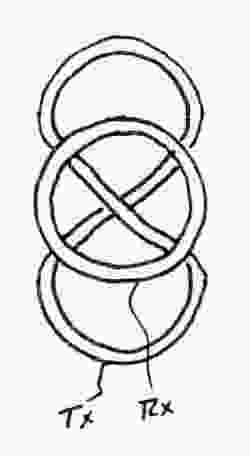In Part 30 I forgot to mention that you can get negative signals from the coil when the target is in certain regions of the coil's field.
With a concentric coil the signal is positive when the target is centered under the coil. But if the target is close enough to the coil the signal may go negative at one or more points as the target is moved from the center to the edge of the coil. If the target is far enough away from the coil the signal will always be positive.
Differentiating coils will give a negative signal half the time. These coils have a figure 8 winding and have a signal null along the centerline of the coil. On one side of the null the signal will be positive, and on the other side of the null it will be negative. In some coils the null runs from front to back. In this case as you sweep left and right all targets cross the null and produce both + and - signals. In the Bigfoot coil the null runs side to side so targets under the front half of the coil give a + signal, and targets under the back half give a -.
I don't have any DD coils but I would expect them to have negative signal areas to the right and left of the center positive area.
Robert Hoolko
With a concentric coil the signal is positive when the target is centered under the coil. But if the target is close enough to the coil the signal may go negative at one or more points as the target is moved from the center to the edge of the coil. If the target is far enough away from the coil the signal will always be positive.
Differentiating coils will give a negative signal half the time. These coils have a figure 8 winding and have a signal null along the centerline of the coil. On one side of the null the signal will be positive, and on the other side of the null it will be negative. In some coils the null runs from front to back. In this case as you sweep left and right all targets cross the null and produce both + and - signals. In the Bigfoot coil the null runs side to side so targets under the front half of the coil give a + signal, and targets under the back half give a -.
I don't have any DD coils but I would expect them to have negative signal areas to the right and left of the center positive area.
Robert Hoolko



Comment